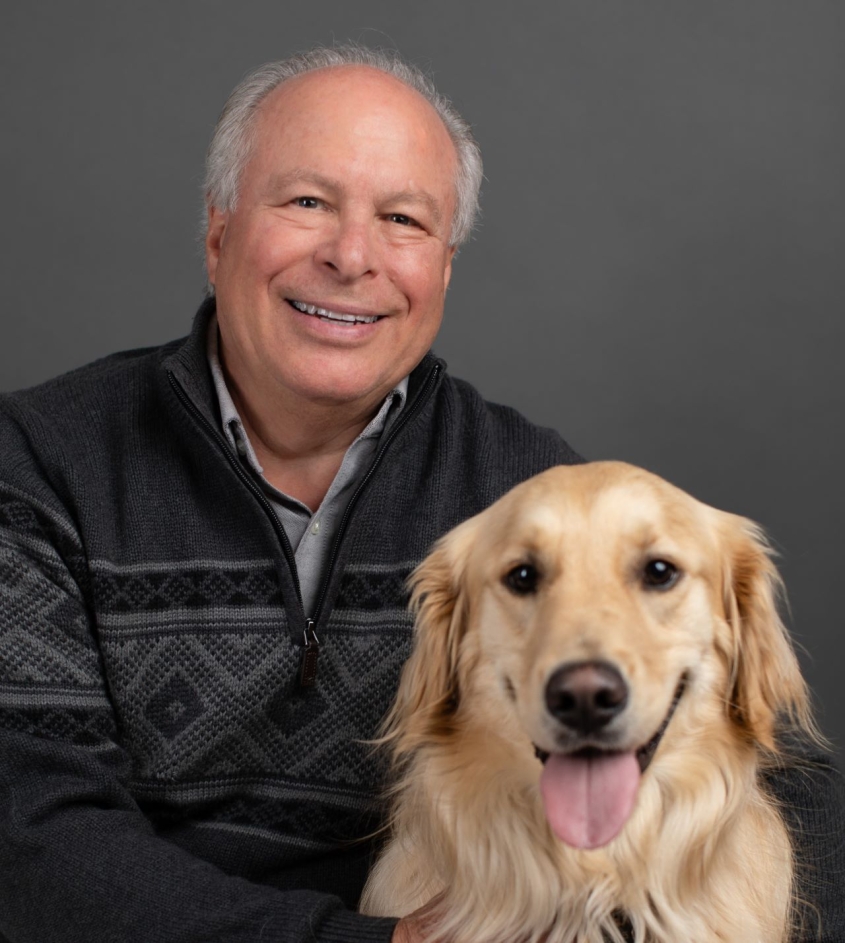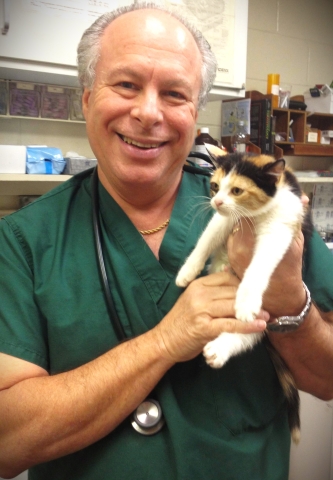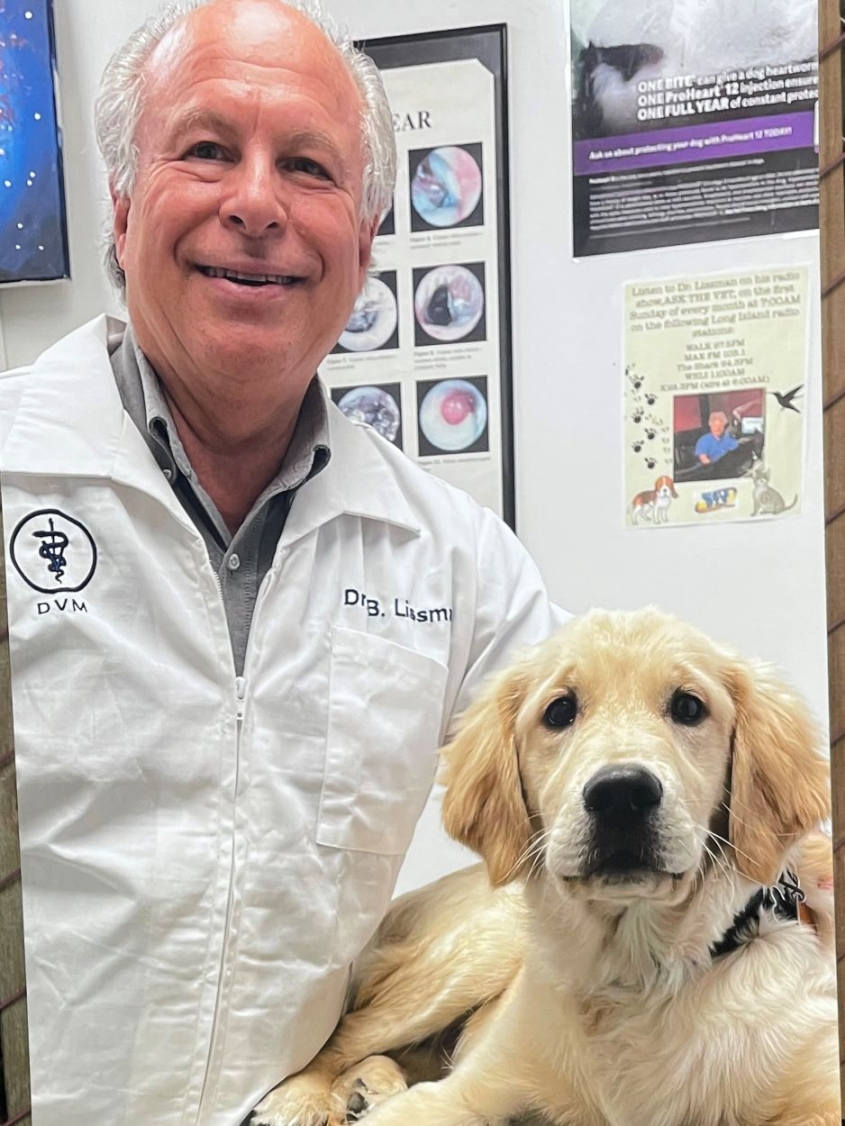Barry Lissman ’74, D.V.M. ’77: The disease-discovering doctor
Veterinary medicine can be rich with career paths and opportunities. Barry Lissman ’74, D.V.M. ’77, may be one of the best examples of that fact. Not only has he helped found a zoo, lead a county-wide anti-rabies initiative and serve as the resident veterinary expert on a nationally syndicated TV news program and radio show, but he also has the remarkable distinction of being the first person to identify both Lyme disease and Rocky Mountain Spotted Fever in dogs — all while working as a full-time private practice clinician.
His achievements have now earned Lissman the Cornell University College of Veterinary Medicine’s (CVM) highest award for alumni — The Daniel Elmer Salmon Award for Distinguished Alumni Service. The award recognizes veterinary graduates who have distinguished themselves in service to the profession, their communities or to the college. It was established by the CVM Alumni Association in 1986 and named in honor of Cornell's first D.V.M. graduate, Daniel Elmer Salmon. Salmon is best remembered for his pioneering work in controlling contagious animal diseases in the early twentieth century and the bacterium Salmonella that was named in his honor.
“Dr. Lissman’s original research was groundbreaking and has had an indelible effect on veterinary medicine,” says Mitchell Kornet ’76, D.V.M. ’79. “He has been an outstanding leader in veterinary medicine for more than 40 years, and embodies the qualities, accomplishments and ideals of a recipient who deserves to be recognized. Dr. Lissman is a trailblazer and mentor to so many, and has chosen to give back to our profession in countless ways.”
Lissman, like so many other veterinarians, knew his calling from early on — age 10, according to his mother’s journal. However, unlike many future veterinarians, he lived in the middle of Queens, where getting access to a variety of animals was tricky. Fortunately, he was accepted into John Bowne High School, which has a widely respected agricultural program (to this day, Lissman regularly visits the school to mentor students). From John Bowne, he was able to gain acceptance to Cornell University’s College of Agriculture and Life Sciences and later the CVM’s veterinary program.
“During my tenure as a member of the Cornell faculty from 1976 to 1996, I interacted with many good students and a few great students. Dr. Lissman was one of the great students,” says Dr. Victor Rendano, former faculty member in the Department of Clinical Sciences. “His brain was constantly working to understand why something is as it is; and if it needed improvement, how to make it better.”
At Cornell, Lissman thrived under the mentorship of professors like Rendano and the legendary Alexander de Lahunta, D.V.M. '58, Ph.D. '63, emeritus James Law Professor of Anatomy, the camaraderie of his fellow classmates, and the support of Wendy, whom he would marry after his sophomore year of veterinary college.
Upon graduation, he and Wendy returned downstate, and soon Lissman started his own mobile private practice on Long Island (the first mobile clinic in New York at the time), and later several brick-and-mortar hospitals in the area.
Unusual discoveries
It was within two years of graduation that Lissman’s first major discovery took place. “I was working as an associate veterinarian at a hospital, and there was an interesting case that no one could figure out what it was,” Lissman says.
The one case soon turned into four; their symptoms included high fever, abdominal pain, anorexia and depression. Their clinical signs disappeared after they received treatment with the antibiotic tetracycline.
Veterinarians had long suspected that such cases were caused by tick-transmitted rickettsia bacteria, but the research had focused on tick-borne diseases in humans alone. Lissman wanted to investigate these canine cases further, scouring the literature and calling his former CVM instructor, Dr. Jay Georgie, professor emeritus of parasitology, for insight. It was known that Rocky Mountain Spotted Fever (RMSF) was endemic to Long Island, with many human cases popping up each year — but there was nothing in the literature about RMSF in dogs.
Lissman persisted. “I have a natural desire to not just drop things and say, ‘Oh well, I don’t know what it is,’ because that doesn’t help my clients and my patients,” he says. “I wanted to dig deeper, and my training at Cornell really helped with that.”
So Lissman reached out to a leading tick-borne researcher at Stony Brook University, Dr. Jorge Benach, leading to a collaboration between the two where Lissman collected ticks and blood samples from his patients and sent them to Benach, who analyzed them in his lab.
“Lo and behold, Benach developed the test from the blood samples I sent, and we identified the first incidence of Rocky Mountain Spotted Fever in dogs,” Lissman says. Their finding was published in JAVMA in 1980, just under two years after he graduated from veterinary school.
“Unlike researchers in an academic institution, Dr. Lissman didn’t have the typical resources that were available to other scientists,” says Kornet. “Instead, he forged his own path to discover the cause of the disease that was making the dogs on Long Island ill.”
Meanwhile, Lyme disease was becoming endemic in Long Island. “Benach told me, ‘Keep an eye out for Lyme,’” Lissman recalls. Sure enough, not long after, a Doberman pinscher arrived in his practice with unusually swollen joints. After ruling out all other common diseases, Lissman reached out to Benach, who was able to culture the bacteria from the Doberman’s blood sample Lissman provided, developing the first known test for Lyme disease in dogs. This discovery soon led to another foundational JAVMA publication in 1984, “Spirochete-associated arthritis (Lyme disease) in a dog.”
“Once again, Dr. Lissman demonstrated that he was a unique veterinarian who possessed the drive to go beyond the limits of what was known at the time,” says Kornet. “His discovery was monumental and his contributions to the pathogenesis of Lyme disease is cited in virtually every scientific paper that has been written about Lyme disease.”
Lissman’s professional peers recognize that such foundational contributions to veterinary medicine are no small feat. “Dr. Lissman is exceptional in that he did it while his primary service was as a front-line health care provider, not as a dedicated researcher or a board-certified specialist,” says Rendano.
In recognition of these foundational discoveries, Lissman was awarded the Practitioner Research Award from the American Veterinary Medical Association, the Outstanding Service to Veterinary Medicine Award from the New York State Veterinary Medical Society, and two merit awards from the Long Island Veterinary Medical Association.
Going above and beyond
For many private practitioners, this would have been a natural point to rest on their laurels. Not so for Lissman. Suddenly the world expert on these new-found canine diseases, he followed his foundational publications with lectures on the topic both nationally and internationally, all the while working with the Cornell Animal Health Diagnostic Center (AHDC) to supply samples for creating diagnostic tests, and continuing to publish over a dozen scientific articles and chapters.
Beyond research, Lissman was also dedicated to service, acting as a board member and chairman for a period of time for the New York State Board for Veterinary Medicine as well as the New York State Veterinary Medical Society and the Long Island Veterinary Medical Association, roles in which he oversaw rabies vaccination efforts in the area in collaboration with then-AHDC director Donald Lien, D.V.M. ’57, himself a Cornell Salmon Award recipient. Lissman was also the veterinary liaison for the Suffolk County’s disaster preparedness organization, and was instrumental in ensuring that all veterinary hospitals and animal shelters were successfully evacuated during the historical Sunrise wildfire in Westhampton in August 1995, a four-day blaze that decimated 5,500 acres of the Central Pine Barrens and one of the largest wildfires in New York State’s history.
Lissman didn’t stop there. A one-time request for him to appear on a live pet advice segment for a nationally syndicated television show soon turned into a three-year, regular engagement. That opportunity later led to Lissman’s “Ask the Vet” radio show, which ran for 20 years, and became the most-listened program during its time slot on Long Island. Despite the celebrity status earned by his time in the media, Lissman says it had never been his goal. “I never wanted to be on TV. All I ever wanted to do was be in private practice,” he says. But fate continued to push Lissman along a more expansive path, including when the Suffolk County supervisor approached him to help establish the first zoo in their region, working with Bronx zoo veterinarians and reading up on zoo medicine textbooks to advise on providing optimal care and housing for rescued wildlife.
Throughout all his other activities, Lissman continued to stay dedicated to building knowledge around the tick-borne diseases he first discovered. “Since those days of discovery, Barry has been active in the development of the canine vaccines for Lyme disease, acting as consultant and as clinical collaboration for phase 2 and 3 trials,” Benach says of his colleague. “Because of the prevention work with the vaccines, canine Lyme disease may well be undergoing an epidemiological change reflecting a decrease in incidence. I am struck by the magnitude of the actual discovery and how it led to prevention in a mere 40-plus years. Not many investigators can claim such accomplishments.”
After his myriad accomplishments in research, service and outreach — not to mention 45 years of private practice on Long Island, Lissman retired to the Philadelphia region with Wendy (and their golden retriever Ruggles and two cats, Honey and Lucy) to be closer to their daughters, Erica and Rachel, and their three grandchildren, Hannah, Benjamin and Dara.
At long last, perhaps, Lissman can reflect on the rich and remarkable path his professional journey has taken him on. “l loved every minute of it,” he says. “I wouldn’t change a thing.”
Written by Lauren Cahoon Roberts








